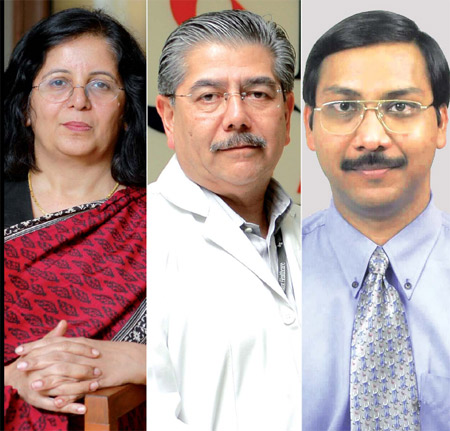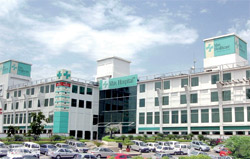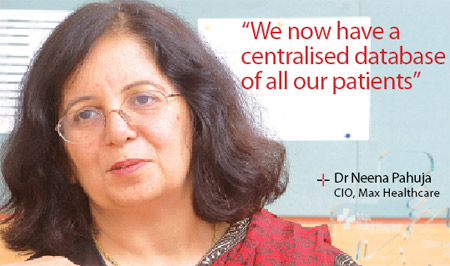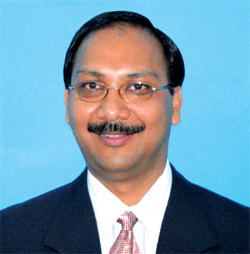MAXimising Benefits

By Divya Chawla
The IT outsourcing deal puts Max Healthcare on the roadmap for becoming the best IT-enabled hospital chain in the country
 The Indian healthcare system has recently realised the potential of information and communication technologies in completely transforming care delivery at hospitals. The industry witnessed its first complete IT infrastructure technology outsourcing deal in September 2009, when Max Healthcare and Dell Services (formerly Perot Systems) partnered for developing IT operations at all Max Hospitals. The cost of the deal, Rs 90 crore (excluding infrastructure cost), is an indicator of the increased priority that is now being given by Indian hospitals to IT, which is an extremely positive sign. As per the agreement, the deal will last for ten years, out of which one year has already passed, and a lot of positive transformation has already been noticed. The unique partnership is not only expected to provide a lot of value to Max Healthcare in terms of enhancing the quality of services and reducing treatment costs, but it will also be a great learning experience for Dell, which marked its entry into the Indian healthcare market with this deal.Status updatePost its inception in September 2009, the ITO deal will last for 10 years and which, according to Dell, will comprise of three major phases – transition, improving productivity and optimisation. As one year has passed, the transition phase is almost over. During this phase Dell installed the entire IT infrastructure for Max, by migrating the already existing IT infrastructure to a modern infrastructure. The entire data centre of Max, which was housed in their Okhla office, was migrated to the Dell facility in Noida. To reduce hassles, the shifting work was done during off hours on weekends, so that the work at the hospitals does not get affected. The entire process lasted for a couple of months and currently all Max Hospitals are running from the data centre housed in the Dell facility in Noida. The servers and network devices have been installed with monitoring devices that generate alerts in case a problem arises. There is also a situation management process in place to ensure that even the problems of highest criticality get resolved within a definite period of time.
The Indian healthcare system has recently realised the potential of information and communication technologies in completely transforming care delivery at hospitals. The industry witnessed its first complete IT infrastructure technology outsourcing deal in September 2009, when Max Healthcare and Dell Services (formerly Perot Systems) partnered for developing IT operations at all Max Hospitals. The cost of the deal, Rs 90 crore (excluding infrastructure cost), is an indicator of the increased priority that is now being given by Indian hospitals to IT, which is an extremely positive sign. As per the agreement, the deal will last for ten years, out of which one year has already passed, and a lot of positive transformation has already been noticed. The unique partnership is not only expected to provide a lot of value to Max Healthcare in terms of enhancing the quality of services and reducing treatment costs, but it will also be a great learning experience for Dell, which marked its entry into the Indian healthcare market with this deal.Status updatePost its inception in September 2009, the ITO deal will last for 10 years and which, according to Dell, will comprise of three major phases – transition, improving productivity and optimisation. As one year has passed, the transition phase is almost over. During this phase Dell installed the entire IT infrastructure for Max, by migrating the already existing IT infrastructure to a modern infrastructure. The entire data centre of Max, which was housed in their Okhla office, was migrated to the Dell facility in Noida. To reduce hassles, the shifting work was done during off hours on weekends, so that the work at the hospitals does not get affected. The entire process lasted for a couple of months and currently all Max Hospitals are running from the data centre housed in the Dell facility in Noida. The servers and network devices have been installed with monitoring devices that generate alerts in case a problem arises. There is also a situation management process in place to ensure that even the problems of highest criticality get resolved within a definite period of time.The second part of the transition phase comprised of the application part. With eight applications already in place, Dell is now building an all extensive Electronic Health Record (EHR) system for Max. Based on the VistA open source, initially developed by the Veterans Affairs (VA) in the US, the EHR at Max is expected to take some more time before it can become fully functional at all Max facilities. Max decided upon implementing VistA by customising it as per Indian needs, so that the best practices can be brought to India. In addition to creating electronic health records for all in-patients, Max plans to go a step ahead by creating records for the out-patient department, as well. This will be the first-of-its-kind initiative in India. The record for out-patients will be maintained for a certain period of years, as required to manage data storage constraints. Max Healthcare strongly believes that once the EHR system is in place, the benefits for management, physicians as well as patients at Max will increase tremendously. A more recent update has been the conversion of the entire IT infrastructure of all Max Hospitals on a private multi-protocol label switching (MPLS) cloud running remotely from data centre at Dell facility in Noida. This step has set the stage for the launch of the EHR system at Max in the coming times. The required bandwidth is being provided by Bharti and Reliance to ensure load balancing, which is around 15 Mbps by each vendor. As the load of applications increases, Max is ready to enhance this bandwidth to manage all applications. A significant advantage that this cloud will offer is the capability to add more hospitals/networks as and when required without any hassles. With the MPLS cloud in place making new hospitals/facilities IT enabled will be a cakewalk as they only need to be connected to the cloud.While the transition phase is almost over, Dell believes that it will take another year for the productivity improvement phase to finish, where Dell will focus on redeveloping and improving all inefficiencies, if any, to make the functioning of all IT operations seamless. The final phase will comprise of optimising all processes. All these phases would take around 3-4 years to get completed, before Max can actually start reaping the benefits of IT implementation.
A more recent update has been the conversion of the entire IT infrastructure of all Max Hospitals on a private multi-protocol label switching (MPLS) cloud running remotely from data centre at Dell facility in Noida. This step has set the stage for the launch of the EHR system at Max in the coming times. The required bandwidth is being provided by Bharti and Reliance to ensure load balancing, which is around 15 Mbps by each vendor. As the load of applications increases, Max is ready to enhance this bandwidth to manage all applications. A significant advantage that this cloud will offer is the capability to add more hospitals/networks as and when required without any hassles. With the MPLS cloud in place making new hospitals/facilities IT enabled will be a cakewalk as they only need to be connected to the cloud.While the transition phase is almost over, Dell believes that it will take another year for the productivity improvement phase to finish, where Dell will focus on redeveloping and improving all inefficiencies, if any, to make the functioning of all IT operations seamless. The final phase will comprise of optimising all processes. All these phases would take around 3-4 years to get completed, before Max can actually start reaping the benefits of IT implementation.
The benefit quotient
The IT implementation at Max Healthcare will not only benefit the management and physician community, but it will also be extremely advantageous for the patients. This would be the first time in the country when electronic health records for the out-patient department will be maintained.
| The rapid developments at Max have happened because of the ITO model they adopted”
Dr Pankaj Gupta What were the major challenges being faced by Max? How will Dell’s solutions help Max overcome these challenges? Max had an in-house IT team of about 15 people and they had a few vendors who were supporting IT services. However, this model was not giving them enough value as a lot of capital was being invested with insufficient return on investment. Moreover, Max was looking at having one entity that can manage all IT processes and they wanted to outsource these services and that is how they joined hands with us.We are responsible for the infrastructure services as well as the applications at Max. Infrastructure starts right from cables, servers, network devices, data centres, day-to-day operations and so on. Max already has eight different applications and further we are implementing a VistA EHR application. We migrated the existing IT infrastructure at Max to a modern infrastructure. There was a transition project, when we joined Max, in which we started from a point where the data centre was situated in Max Hospital at Okhla. We migrated that to our data centre and all other Max hospitals are now running from our data centre at Noida. This was a huge project, which lasted for a couple of months. We also took over 14 of their people, who are now a part of our team. As a strategic decision, we did not take over the office of the CIO because somebody was needed to be there at Max as a signing authority. We put automatic monitoring devices on the network devices and servers. If there is any sort of problem in the functioning, the monitoring devices raise an alert. If the issue is not acted upon within a certain time frame, people are required to sit on a SitMan bridge, which is a situation management process. On the network side, we migrated everything to an MPLS cloud. The infrastructure is now ready, and we just need to put all other applications. Tell us about the governance process that has been put in place at Max. We set a complete governance process for Max internally. We did this because this is part of our model and we want to bring in the best practices to Max. For this, we set up a Clinical Reference Group (CRG), which is headed by a very senior physician within the hospital. This group has physicians and representatives from almost all departments. Further, we have sub-committees of the CRG. We consolidated all sub-committees so that when the EHR comes, a joint decision can be taken. We also set up an HIS council for Max to prioritise all processes on the admin side of the business. This council is headed by one of the hospital administrators. On top of these two councils, we have another council which is headed by the CEO. Any decisions taken by these two councils gets rolled up in the governance council and the policies become implemented throughout. On top of the governance council, there is an utive council, which has members from both organisations at the board level as well as very senior utive level. Initially decision making was difficult, however, with the governance process now in place these issues have got resolved. Why did Max choose VistA for its EHR? VistA was developed by and for the Veterans Affairs (VA) in the US, which is an equivalent of Military hospitals in India. All VA hospitals, about 1000, in the US, run on VistA. A very few organisations have implemented VistA outside the US. As per the FOIA act in the US, VA could not have proprietary rights over the software because it was developed using the tax payers’ money and hence it was put in the open source and that was the time when World VistA was created. Max wanted to pick up the open source VistA to build best practices on it that can be used anywhere in India. VistA has everything that is required for a hospital to run. It has the clinical functions for all departments and the ancillary functions including laboratory, radiology pharmacy. The only thing that VistA lacks, from an Indian context, is billing and material management. |
Although, this would be a big challenge for Max in terms of storing such huge amounts of data generated by the OPD, yet they are confident that the benefits achieved because of this will outweigh the challenges. Moreover, each and every patient at Max will be provided with a unique URL, that will store all patient information. They can access this URL from anywhere in the world and have instant access to their clinical data, be it – laboratory reports, radiology images, drug details or any other clinical data. This means that the patients would not need to carry their paper records anywhere as all all information would be available online.For physicians, taking decisions and offering treatment would become much simpler as they would have access to all patient data, instantly. Moreover, as the healthcare industry moves towards evidence-based medicine, the data availability because of the EHR module, would present all information specific to a particular diseases, making the process extremely simple and foolproof. Further, with computerised physician order entry (CPOE) based system in place, the job of the physician will be further simplified as they will receive continuous guidance from the system.Similarly, the decision making process for the management will become much simpler as soon as they have availability of sufficient data. The management would be able to strategise in the right direction and bring in the best class care. This would not only help them enhance the quality of services offered, but will also help in overall business growth.
On the infrastructure side, with the completely modernised infrastructure in place, the chances of system failure or any sort of mishaps have almost been reduced to nil. Further automatic monitoring devices have been installed everywhere, that would immediately raise alerts in case of any problem. Dell has included a unique situation management process called the SitMan bridge, with which all queries and problems will get resolved in a definite period of time. With so much in place already, Dell believes that Max Healthcare is yet to realise the real benefits. At the end of the first 3-4 years, when the optimisation phase is over, that is when Max will reap the maximum benefits from this system.
|
Max Healthcare IT Outsourcing Project: Snapshot Phase I:Infrastructure Upgradation
Phase II: Building on Extensive Health Record System for Max
Phase III: Building New Applications on the Robust Infrastructure
|
 According to calculations made by Max, the entire project would reduce the average time of stay of a patient in the hospital by one day. Further adding to this, reduced paper costs will help Max save around `2.5-3 crore, per year.While, the challenges for both Dell and Max have been many, this deal is expected to bring them much more than they would have expected. Max is confident that the completion of the entire project, would put them on the top as far as use of IT is concerned within a hospital environment. The deal would put Max on the roadmap for achieving their aim of becoming a world class level 7 hospital and have the right technologies to bring in a safe environment, increase accessibility of healthcare and reduce waste as much as possible.On the other hand, the deal would provide Dell Services the right learning experience in the Indian healthcare market. The biggest benefit that this would provide would be for the Indian healthcare industry is concerned by setting the trend for enhanced IT adoption and IT outsourcing by Indian hospitals.
According to calculations made by Max, the entire project would reduce the average time of stay of a patient in the hospital by one day. Further adding to this, reduced paper costs will help Max save around `2.5-3 crore, per year.While, the challenges for both Dell and Max have been many, this deal is expected to bring them much more than they would have expected. Max is confident that the completion of the entire project, would put them on the top as far as use of IT is concerned within a hospital environment. The deal would put Max on the roadmap for achieving their aim of becoming a world class level 7 hospital and have the right technologies to bring in a safe environment, increase accessibility of healthcare and reduce waste as much as possible.On the other hand, the deal would provide Dell Services the right learning experience in the Indian healthcare market. The biggest benefit that this would provide would be for the Indian healthcare industry is concerned by setting the trend for enhanced IT adoption and IT outsourcing by Indian hospitals.
uld_count:
Cookie not set
Value 1: 0
Value 2: 10









